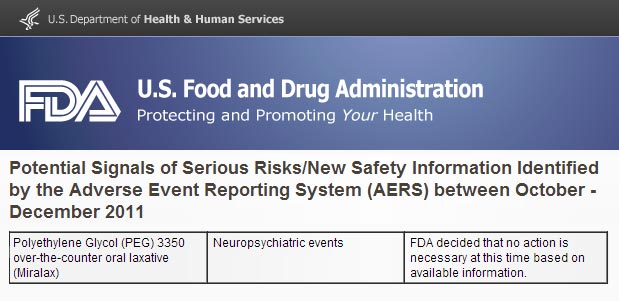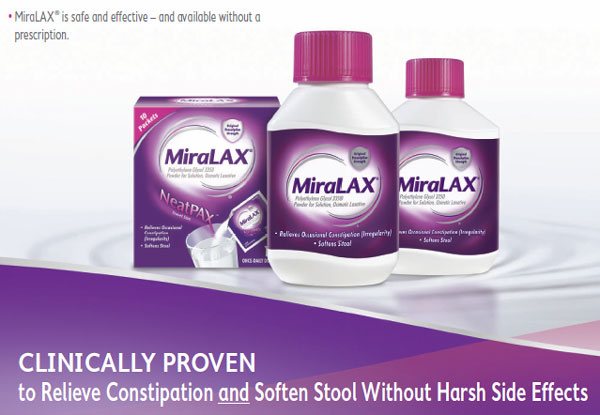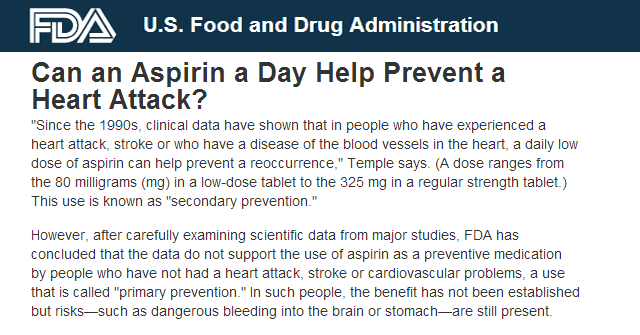Is MiraLAX the next Vioxx?
Are you getting mad or forgetful after taking a laxative? Well, according to the US Food and Drug Administration, that's what certain best-selling laxatives can do to you.
Back in December of 2011, the FDA placed MiraLAX — a polyethylene glycol-containing blockbuster drug marketed by Merck & Co — on its Adverse Event Reporting System (AERS) in connection to “neuropsychiatric events.”
Besides MiraLAX, this warning also applies to Movicol, Dulcolax, Colyte, Colovage, Co-Lav, Clensz-Lyte, ClearLax, GoLYTELY, GaviLyte C, GlycoLax, Go-Evac, GlycoPrep, E-Z-Em Fortrans, Halflytely, Lax-a-Day, LaxLyte, MoviPrep, Macrogol, NuLytely, OCL, Peg-Lyte, Prep Lyte, Softlax, TriLyte, and all other brands with Polyethylene Glycol 3350 (PEG for short) as their active ingredient. The “3350” qualifier refers to the molecular weight of this particular variant of PEG.

The cutout from the MiraLAX-related posting on the FDA's website [1].
Polyethylene glycol is made by stringing together molecules of ethylene glycol into a large polymer chain, hence the prefix poly-, Greek for many. On its own, ethylene glycol is used in automotive antifreeze and brake fluid. According to the National Institute for Occupational Safety and Health, it is an extremely toxic substance:
“Ethylene glycol is chemically broken down in the body into toxic compounds. It and its toxic byproducts first affect the central nervous system (CNS), then the heart, and finally the kidneys. Ingestion of sufficient amounts [as little as 30 ml — KM] can be fatal.” [2]
The term “neuropsychiatric events” in the FDA's safety alert refers to neurologic disorders of the central and peripheral nervous systems such as autism, dementia, depression, schizophrenia, multiple sclerosis, Alzheimer’s and Parkinson’s diseases, and similar others [3]. These conditions result from PEG's direct (through cellular damage) and indirect (through malnutrition of essential micronutrients) neurotoxicity. No surprise there considering the quotation above.
Lead, mercury, and arsenic are some of the best-known neurotoxins. So are snake venom, curare, botulinum, and tetanus. PEG is more like lead or mercury — slow-acting, insidious, and difficult to pin down conclusively onto various “slow-brewing” neurological disorders.
In addition to neurotoxicity, the following serious complications have been associated with polyethylene glycol-containing laxatives:
-
Nephrotoxicity: PEG has been connected to nephrotoxicity — a euphemism for kidney damage — when used as a drug solvent [link, link] or when applied to the skin [4]. For these reasons, PEG is contraindicated for patients with kidney disease. This particular “side effect” is most likely related to the hydrolyzed (separated in water solution) molecules of ethylene glycol.
-
Urticaria: PEG may cause allergy-related hives (urticaria) — raised red welts on the surface of the skin. Children are particularly susceptible to hives and face a grave risk of anaphylaxis. This life-threatening allergic reaction may develop within minutes or even seconds after ingesting a PEG-containing laxative. Links between PEG and urticaria have been documented as far back as 1991 [link].
-
Esophageal perforations: Also known as Mallory-Weiss tear, esophageal perforations associated with polyethylene glycol-based electrolyte lavage solution have been reported as far back as 1991. These tears and related bleedings may occur in the mucus membrane of the lower part of the esophagus or upper part of the stomach [link].
This particular side effect isn't directly related to MiraLAX, which is taken in smaller doses. Still, the potential is always there, particularly among young children or patients with GI tract obstruction that may initially manifest as constipation.
-
Encopresis. The involuntary passage of stools in toilet-trained children is one of the nastiest side effects of taking PEG-containing laxatives. The same condition may affect adults, and for the same reasons — a continuous leakage of semi-formed stools from the large intestine, an outcome of PEG “working” too well.
All of the “collateral damage” from PEG shouldn't surprise anyone, least of all seasoned chemists, pharmacists, and medical doctors. This industrial chemical is manufactured by The Dow Chemical Company for use in wood treatments, paints, coatings, rubber, textiles, detergents, and toilet bowl cleaners [5].
The stock (© iStockphoto LP) illustration from the cover page of the Carbowax™ product brochure by The Dow Chemical Company, a leading manufacturer of industrial PEGs.
Technically, PEG is an osmotic laxative. Because of this property, it blocks the absorption of nutrients in the small intestine. Its extended use may result in severe malnutrition-related disorders, particularly in young children and older adults. Autism is one such disorder. It may take only two weeks of an acute iron or iodine deficiency to cause autism in a child younger than two.
The same properties of PEG that make it an excellent toilet bowl cleaner also wipe clean the mucosal membrane of the large intestine, leaving the colon unprotected and cancer-prone, a situation similar to a dry mouth. On top of the mucosal membrane damage, a high osmotic gradient of polyethylene glycol solution decimates intestinal bacteria — single-cell organisms — just as mercilessly as antibacterial soaps, antibiotics, or heavy metals.
The resulting deficiency of intestinal bacteria is called dysbiosis in the United States and dysbacteriosis in the rest of the world. Dysbiosis reduces primary immunity, causes a broad range of neurological and blood disorders, makes occasional constipation chronic and more severe, ensures lifelong dependence on laxatives, and is behind ulcerative colitis, Crohn’s disease, and colorectal cancer.
Dysbiosis is also behind premature aging, which is self-evident in the early graying of the hairs, type 2 diabetes, facial wrinkles, patchy skin, weak nails, tooth loss, arthritis, and osteoporosis. These particular pathologies may be related to the deficiency of biotin (vitamin H) and vitamin K, which are, under normal circumstances, synthesized by the healthy intestinal flora. The PEG's blocking effect on the absorption of vitamins and minerals in the small and large intestine also plays a role.
When PEG is combined with a high fiber diet — a standard remedy for dysbiosis — problems double up because indigestible fiber tends to enlarge stools. In turn, large stools lead to straining. This habit becomes a primary cause of enlarged hemorrhoids, anorectal nerve damage, anal fissures, diverticular disease, fecal obstruction, and rectocele (a protrusion of the rectovaginal wall inside the vagina).
A single recommended dose of MiraLAX contains 17 grams of pharmaceutical grade PEG powder [6]. It is a vast amount of what is otherwise an industrial-strength anti-fungicide, insecticide, and germicide strong enough to preserve wood beams, railroad ties, and electrical poles from fungi, insects, and bacteria practically forever. It works by displacing water in the wood, which makes it resistant to warping and rotting.
It's so ironic! The same people who will go out of their way to "eat organic" to avoid traces — we are talking micrograms — of fungicides, insecticides, and germicides in their foods, will then go on and ingest a heaping tablespoon of polyethylene glycol-containing laxative without blinking an eye. Or give it to their children.
Despite all of its well-established risks, MiraLAX has never been tested for safety in pregnant women and children:
“Safety and effectiveness [of PEG] in pediatric patients has not been established. ” “Animal reproductive studies have not been performed with Polyethylene Glycol 3350 NF. It is also not known whether Polyethylene Glycol 3350 NF can cause fetal harm when administered to a pregnant woman, or can affect reproductive capacity...” [7]
For these and other prudent reasons, MiraLAX was approved by the Food and Drug Administration back in 1999 ONLY for use by adults and for NO LONGER than SEVEN days. Despite of this clear and unambiguous rule, pediatricians routinely prescribe PEG-containing laxatives to children of all ages [8] anyway. Equally disturbing, many doctors encourage adults and children alike to take them indefinitely, even though the label clearly states: “Use no more than 7 days.”

The cutout from the MiraLAX product label [9].
A citizen petition “To Investigate Polyethylene Glycol 3350 Product Safety for Use with Pediatric Patients” was filed with the U.S. Federal Drug Administration on June 6, 2012. Here is what it said:
“As of March 2012, the FDA Adverse Event Reporting System showed 2257 reported adverse events related (in any way) to PEG products - up from 7 in 2001. Included in the adverse events reported are serious kidney, urinary, bowel, blood, skin, and neuropsychiatric symptoms - and at least 3 children's deaths. [PDF link]"
Only a tiny percentage — around 1% — of severe side effects ever get reported to the FDA [link]. It's probably even less with MiraLAX and its clones. Unlike with prescription drugs, making direct connections with PEG side effects is far more challenging because so many of them aren't immediate; or because nobody expects to encounter severe complications from a "mere" over-the-counter laxative; or because small children can't communicate their sufferings in words; or because it's so hard to identify whodunit among adults who are already taking a daily cocktail of other potent drugs; or because these outcomes are falsely blamed on genetics, environment, and old age.
The use of laxatives is widespread throughout pregnancy. It's possible ethylene glycol molecules may penetrate the placenta and cause neurological damage in fetuses. Infants may be equally affected via breast milk, or milk supply may be poor quality or too low. And that's on top of the maternal malnutrition and neurological damages I've described above.
Notably, MiraLAX was introduced back in 1999 [10], about the same time, the epidemic of autism began sweeping across the United States in earnest. It doesn’t take a Ph.D. in epidemiology to infer a possible connection between these two happenings.
If anyone you know is pregnant or nursing, please let them know about the possible role of polyethylene glycol-containing laxatives in autism, postpartum depression, and other neurologic disorders. The connection between these conditions and MiraLAX has never been conclusively proven because conducting this kind of clinical research is illegal. Still, as a lawyer might say, “the preponderance of the evidence is overwhelming,” so you are better off being safe now than sorry later, particularly with something as easily avoidable as PEG-containing laxatives.
Laxatives with polyethylene glycol are also a potential menace to seniors who rely on them to alleviate medication-related constipation — a common side effect of taking multiple prescription drugs for depression, insomnia, and hypertension.
Please forward a link to this page to your parents and grandparents, so that they can protect themselves from memory loss, dementia, and Alzheimer’s disease made eerily possible by taking polyethylene glycol-containing laxatives.
Unfortunately, despite all of the above issues and the FDA’s published warning related to polyethylene glycol safety, you still won’t find a hint of concern in MirLAX’s patient literature. All it says: “MiraLAX® is safe and effective – and available without a prescription.”

The cutout from “What Is MiraLAX” product brochure [11].
How can Merck get away claiming that MiraLAX is "safe" and "without harsh side effects?" Well, just as it did with Vioxx, another presumably "safe" miracle drug [12]. Following this well-established pattern, Merck will continue milking MiraLAX's franchise for as long as it can. When the time finally arrives to recall it, Merck's army of lawyers will keep fighting its victims until they'll settle en masse for pennies on the dollar [13]. It's a cost of doing business, nothing personal!
But this ugly story doesn't end with laxatives. It gets even uglier — food-grade polyethylene glycol (under the Carbowax Sentry trade name) is commonly added to chewing gums, table-top sweeteners, and energy drinks. It is also used as a base in solid and liquid soaps, shampoos, bath and shower gels; body and face creams and lotions; toothpaste, ointments, and suppositories; as a tablet binder in drugs and supplements; as a lubricant in vaginal gels and eye drops; and as a solvent in cough medicines and elixirs. Many of those products are used by children of all ages [14].
Stock (© Inmagine, © Corbis/Photosearch) illustrations from the page 5 and page 9 of the Carbowax™ Sentry™ product brochure by The Dow Chemical Company. Deadly persuasive, I must say!
Please alert your family, friends, and colleagues with young children about the dangers of polyethylene glycol in their foods and medicines via your Facebook page, Twitter feed, e-mail, website, or blog.
If you think you or anyone under your care was harmed by taking PEG-containing laxatives, you may report your concerns to the FDA Safety Information and Adverse Event Reporting Program by following this link [MedWatch Voluntary Report for Consumers].
How to wean yourself off MiraLAX?
For an in-depth look at all constipation-related issues, check out the following pages:
» Constipation Unplugged (How to overcome chronic and intermittent constipation). Explains the physiology of constipation and irregularity. A must-read for medical professionals.
» Bull's S..t In The China Shop. Explains why and how high-fiber diets and fiber laxatives contribute to chronic constipation. If you think that by accusing everybody's favorite “health food” of treason, I, somehow, lost my marbles, reading this instructive page may sober you up.
» Overcoming Fiber Dependence. PEG action is somewhat similar to the action of soluble fiber. Since most people taking PEG-based laxatives also consume a lot of fiber, this article is an essential read.
» Restoring Natural Bowel Movements. If your body is still free of irreversible colorectal damage, you should be able to do what our ancestors have done for millennia — move bowels without a second thought or “helping hand” from the likes of MiraLAX.
» Dysbacteriosis (Dysbiosis). This page is a must-read for all PEG users unless you don't mind getting premature gray hair, a feeble mind, absent memory, tremulous hands, withered skin, hard-to-stop bleedings, and impaired immunity. (Hint: all of these conditions are related to the compromised intestinal flora.)
» Restoring Anorectal Sensitivity. The unmistakable urge always precedes a bowel movement. If you are chronically constipated, it means that somewhere along the line, you've mastered the dubious art of urge suppression. This article may help you to un-master it.
» Frequently Asked Questions about all kinds of "constipations," about what to eat and whatnot, and various myths that get people hooked up on laxatives for life if you are an optimist, or 'until death' if you are not. These are the must-read pages if you are planning to have a baby or are raising one already.
These are the must-read pages if you are planning to have a baby, or are raising one already:
» Why Is My Infant Constipated?
» Why Is My Toddler Suddenly Constipated?
» What Are the Causes Of Constipation In Older Children?
» What Is the Connection Between Infant Constipation, Diarrhea, and Autism?
Please read these pages before emailing me a teary "help me" plea. As a medical writer, I can write about these subjects freely, but I can't help your child directly because doing so over email is irresponsible, let alone outright illegal for anyone but a state-licensed pediatrician.
And don't ever forget that the cases of congenital constipation are rare. If healthy infants develop it, it isn't their fault, but yours and, in many cases, of their doctors. If you let this problem fester unresolved until they “grow out of it,” you and your child may end up paying a heavy price for it later.
If you decide to replace PEG-based laxatives with the program recommended on this site, please review these critical caveats: the Hydro-CM program for children. And make sure to consult your doctors before giving the Hydro-CM program to your child. If they plead ignorance or indifference, then ask them the following question:
"Doctor, knowing what we know now about MiraLAX, would you prescribe it to your child?"
This question will most definitely get their attention. And if not, you can always find another doctor.
By pointing out MiraLAX-related risks to medical professionals, you will protect your child's health and future and help other children under their care in a similar situation.
Hi, I have just started using Hydro-C on my 22 month old daughter, she has been constipated since 8 months old. I have noticed that not only has her bowl movements improved greatly, but also her sleep.
After the first dose I gave her, she did not poop right away, but slept well that night. She has not slept more than a 2 hour span of sleep at one time since she was 5 months old. Her sleep is broken up all night long, averaging 40 minutes to an hour at a time and I have to put her back to sleep each time she wakes. (For this reason we co-sleep, or I would not get any sleep at all.)
She now sleeps a 4 hour stretch, with some smaller ones. I have tried everything for both her sleep and her constipation, everything natural, and unfortunately I did use PEG 3350 at the recommendation of a paediatrician, and nothing has helped in any area.
I stumbled across your site when researching what PEG really was (I was told it was just fibre!!) and I thank God that you have informed people about PEG. R.C., Canada (via e-mail)
If you think this article is a tempest in a teapot, you have no idea just how insidiously bad constipation is to someone's health, physical and mental alike. And even more so to a crying baby with little tolerance for pain and inability to describe in words what's hurting her.
Adding insult to injury, after getting nuked with an abdominal CT scan to “diagnose” constipation and then hooked on MiraLAX by the very doctors expected to protect her health, she may end up autistic and cancer-prone for the rest of her life.
All that said, I am not yelling “fire” here for the sake of making a point. To the contrary — this site provides safe, effective, and natural solutions for resolving the nastiest kinds of constipations, and I hope you'll use them.
If you are interested in exploring connections between autism and nutritional deficiencies related to PEG, please check out these articles:
Sullivan KM. Iodine deficiency as a cause of autism. J Neurol Sci. 2009;276(1-2):202; author reply 203 [link].
Hergüner S, Keleşoğlu FM, Tanıdır C, Cöpür M. Ferritin and iron levels in children with autistic disorder. Eur J Pediatr. 2012 Jan;171(1):1436 [link].
Even though dysbiosis — the dearth of intestinal microflora in the large intestine — isn't recognized in the United States as a medical condition, it doesn't mean that there isn't plenty of academic research to support its role in countless pathologies:
Brown K, DeCoffe D, Molcan E, Gibson DL. Diet-induced dysbiosis of the intestinal microbiota and the effects on immunity and disease. Nutrients. 2012 Aug;4(8):1095-119 [link].
Zaffanello M, Zamboni G, Fontana E, Zoccante L, Tatò L.; A case of partial biotinidase deficiency associated with autism. Child Neuropsychol. 2003 Sep;9(3):184-8 [link].
Vitamin K deficiency, The Merck Manual of Diagnosis and Therapy [link].
Bitoin. Beth Israel Deaconess Medical Center [link].
Dieu-Thu Nguyen-Khoa, MD; Vitamin K Deficiency; Etiology; Medscape Reference [link].
When push comes to shove, don't fight your doctors over this contentious topic. Instead, refer them to these references. They are as mainstream as it gets. Incidentally, the "Merck" in the Merck Manual is the same "Merck" as in MiraLAX story. Go figure!
Déjà vu all over again!
On or about May 7, 2014, Merck & Co., Inc. entered into a “definitive agreement” with Bayer AG of Germany to sell their consumer care division — the one behind MiraLAX — for $14.2 billion [link]. This transaction, I believe, is a bad omen for anyone facing chronic constipation, and here is why:
Bayer AG ( €40.2 billion revenue in FY 2013) is the company behind Bayer Aspirin, also known generically as acetylsalicylic acid. Aspirin belongs to a class of non-steroidal anti-inflammatory drugs. It is commonly used to treat pain, high fever, arthritis, inflammation, and promoted to reduce the risk of heart attack (more on this later).
Besides plain and coated aspirin, the company sells Bayer Chewable Aspirin. It is available in 81 mg chewable tablets with “pleasant orange or cherry flavor,” and is promoted on the website shamelessly named wonderdrug.com.
The only class of patients who may need a chewable version of aspirin are small children who can't swallow regular tablets. Not so long ago, this product has been cheerfully sold as Bayer Children's Chewable Aspirin in 80 mg (1.25 grains) tablets:

As you can see from the illustration above, the doses of aspirin recommended for children were incredibly high:
— Up to 800 mg per day between the ages of 2 and 4 years, or two 80 mg tablets up to five times daily for a total of 10 tablets each day;
— Up to 1,200 mg between 4 and 6 (15 tablets total);
— Up to 1,600 mg between 6 and 9 (20 tablets total);
— Up to 2,000 mg between 9 and 11 (25 tablets total);
— Up to 2,400 mg between 11 and 12, or 30 tablets in a single day.
I wonder how many children had been permanently harmed from these recommendations. I don't know when this product was removed from circulation, but judging from the expiration date on the bottle, this insanity was happening as recently as in 1989.
After pressure from pediatricians and regulators, Bayer took the word “Children's” from the label because aspirin is connected to Reye's syndrome — a sudden brain and liver damage among young children who took aspirin for high fever. For similar reasons, pediatric cold syrups with aspirin were quietly removed from the market in the recent past.
Even adults aren't spared from a similar deception. Bayer AG markets Bayer Safety Coated Aspirin with the implied promise that it is safe for the stomach: “Enteric coating is a delayed-released safety coating that provides added stomach protection,” they say.
In reality, an enteric coating DOESN'T offer any protection because aspirin is a systemic drug. It means it causes bleedings not because of its contact with the stomach's mucosal membrane but because it reduces the blood's coagulation. This condition is a frequent cause of death or disability in older adults caused by internal bleedings related to accidental falls, peptic ulcers, vascular ruptures, or hemorrhagic strokes.
Speaking of the prevention of heart attack and stroke with aspirin:
The composite cutout from the FDA's Consumer Update website,
Published on May 5th, 2014 [link].
If you know anyone who takes Bayer Safety Coated Aspirin to prevent a heart attack or stroke, or, God forbid, giving Bayer Chewable Aspirin to their young children, please let them know about their potential harm!
To summarize — expect worse. After all, getting back some of that $14.2 billion investment into the Merck's discards, or keeping the sales of the “wonderdrug” afloat, will require a lot of unsuspecting patients, a lot of complacent (or complicit) medical professionals, and a lot of victims.
To prevent this from happening to your relatives, friends, and associates, please share this life-saving information on your Facebook, Twitter, or LinkedIn pages. As improbable as it may sound, your single click today may save more than one life tomorrow. Thank you!
Click the [link] symbol to view a related web page. Click the Backspace key to return to the original location.
1U.S. Food and Drug Administration, “Polyethylene Glycol (PEG) 3350 over-the-counter oral laxative (Miralax),” Potential Signals of Serious Risks/New Safety Information Identified by the Adverse Event Reporting System (AERS) between October - December 2011, last modified October 18, 2012, [link].
2National Institute for Occupational Safety and Health (NIOSH), "ETHYLENE GLYCOL : Systemic Agent," The Emergency Response Safety and Health Database, last reviewed May 12, 2011, accessed January 16, 2013, [link].
3The Merck Manual for Healthcare Professionals, "Neurologic Disorders," Accessed January 16, 2013, [link].
4F. Alan Anderson, "Special Report: Reproductive and Developmental Toxicity of Ethylene Glycol and Its Ethers," International Journal of Toxicology, 18, no. 2 (1999): 53-67, [link].
5Dow Chemical Company, "CARBOWAX™ Polyethylene Glycols: Innovation, Performance, Flexibility and Quality from the Global Leader in PEGs," published October 2011, [PDF file].
6“MiraLAX easily dissolves in four to eight ounces of water, fruit juice, or any other beverage. And each 7, 14, and 30 dose bottle top is a measuring device that indicates one 17g dose.” –MSD Consumer Care, Inc., “How do I take MiraLAX?,” FAQs, [link].
7Breckenridge Pharmaceutical Company, “Polyethylene Glycol,” Drugs.com, last revised January 2012, [link].
8Catherine Saint Louis, “Drug for Adults is Popular as Children’s Remedy,” New York Times, May 25, 2012, [link].
9“Stop use and ask a doctor if you need to use a laxative for longer than 1 week,” MSD Consumer Care, Inc., “Directions,” “Warnings,” MiraLAX product label, [PDF file].
10“In 1999, when the F.D.A. first approved MiraLAX, the patient materials included the warning: “MiraLAX should not be used by children.” – Catherine Saint Louis, “Drug for Adults is Popular as Children’s Remedy,” New York Times, May 25, 2012, [link].
11Consumer Care, Inc., “What is MiraLAX?,” MiraLAX Product Brochure, page 2, [PDF file].
12“Up to 140,000 extra heart attacks may have been caused in the US by the recently withdrawn drug Vioxx since its launch in 1999.” –Shaoni Bhattacharya, “Up to 140,000 heart attacks linked to Vioxx,” NewScientist.com, published January 25, 2005, [link].
13“Merck settled in late 2007 for a relative pittance, resolving some 50,000 Vioxx cases for just under $5 billion. It was a far cry from the $25 billion to $50 billion in liability that analysts had predicted when Merck withdrew the drug.” –Snigdha Prakash, “The Cover-Up Artist: Why is the CEO of Merck leading the sex-abuse investigation at Penn State?,” Slate.com, posted November 15, 2011, [link].
14The Dow Chemical Company, CARBOWAX™ SENTRY™ Polyethylene Glycols: Innovation, Performance, Flexibility and Compliance from the Global Leader in PEGs,” published October 2011, [PDF file].
All references above were compiled in December of 2012. If any of the links is missing, you can locate it on the Internet Archive website.



